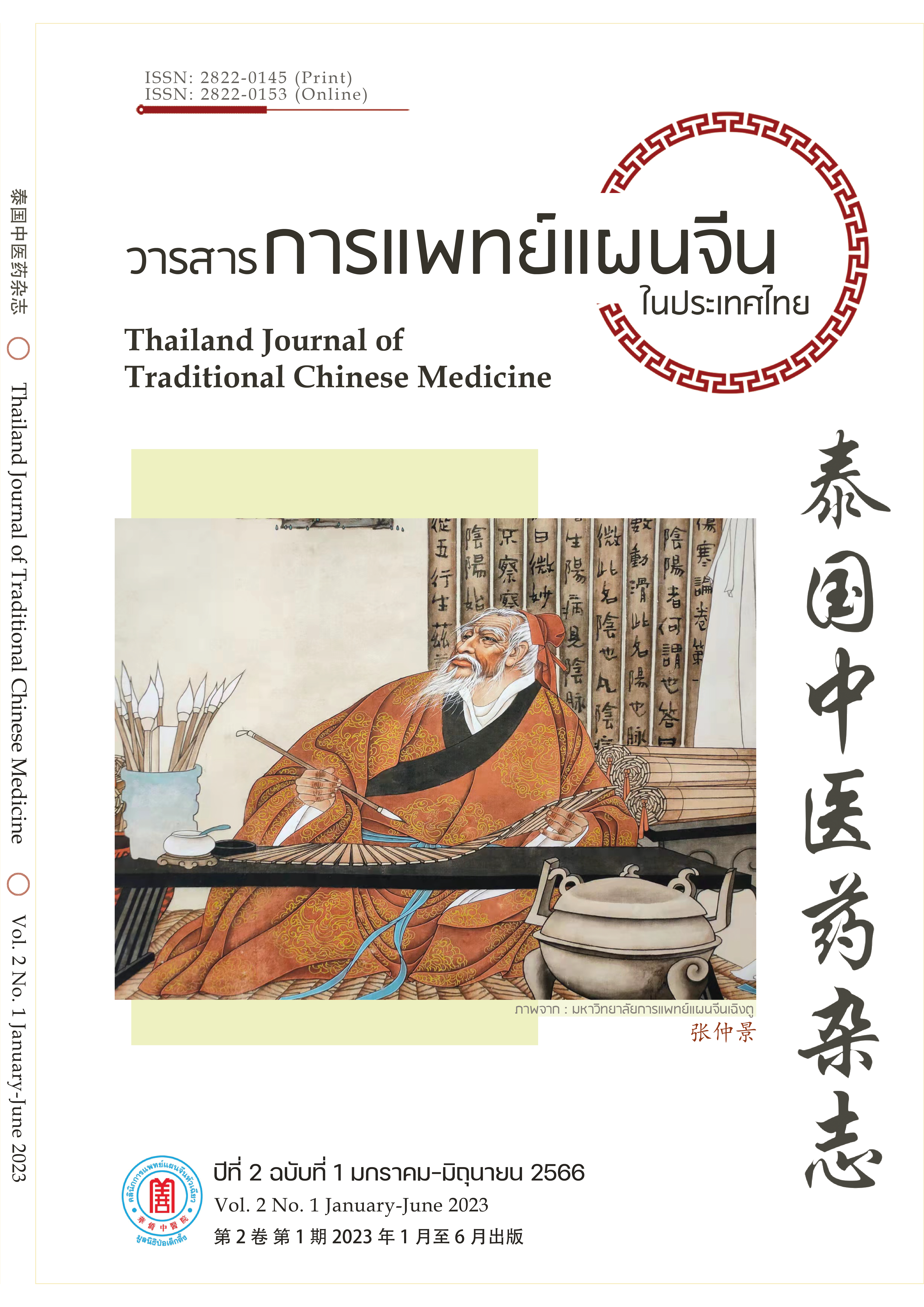มุมมองจากสถาบันขงจื่อ “วัฒนธรรมการแพทย์แผนจีนคือการบูรณาการระหว่างแพทย์กับมนุษย์”
Main Article Content
บทคัดย่อ
วัฒนธรรมคือพฤติกรรมการใช้ชีวิตที่แนบแน่นอยู่ควบคู่กับการใช้ชีวิตประจำวันของคนทั่วไป ส่วนวัฒนธรรมการแพทย์แผนจีนหมายความรวมถึงค่านิยมและแนวทางการใช้ชีวิต และยังเป็นการบูรณาการในระดับสูงระหว่างแพทย์และมนุษย์ แพทย์ต้องถ่ายทอดแนวคิดค่านิยมในขณะที่รักษาโรค ส่วนคนทั่วไปต้องยึดมั่นและควบคุมพฤติกรรมการใช้ชีวิตอย่างต่อเนื่อง ซึ่งจะนำไปสู่การเสริมสร้างวัฒนธรรมการแพทย์แผนจีนแฝงที่ยอดเยี่ยม สถาบันขงจื๊อเป็นส่วนหนึ่งในการส่งออกวัฒนธรรมการแพทย์แผนจีนในประเทศต่างๆ ตามแนว “หนึ่งแถบหนึ่งเส้นทาง” ในประเทศไทยสถาบันขงจื้อไม่ได้เพียงแต่ถ่ายทอดวัฒนธรรมทางภาษาจีนเท่านั้น ยังเป็นส่วนสำคัญส่วนหนึ่งในการถ่ายทอดวัฒนธรรมการแพทย์แผนจีนที่ดีที่สุด ส่งเสริมการแลกเปลี่ยนวัฒนธรรมการแพทย์แผนจีน และหล่อหลอมวัฒนธรรมการแพทย์แผนจีนเข้ากับแนวคิดวิถีชีวิตของประชาชนทั้งสองประเทศไทย-จีน
Article Details
References
Zhang HL, Zhang ZM. Study on Confucius Institute of Traditional Chinese Medicine and Traditional Chinese Medicine Culture Spreading. Chinese Health Service Management. 2011;9(279):718-9. (in Chinese)
Confucius Institute Headquarters Representative Office in the Kingdom of Thailand [Internet]. Introduction to the Confucius Institute of Traditional Chinese Medicine at Huaqiao Chongsheng University [cited 2016 Oct 20]. Available from: http://www.hanbanthai.org/kongzixueyuan/tcihcu/ (in Chinese)
Confucius Institute for Traditional Chinese Medicine at Huachiew Chalermprakiet University [Internet]. The Unveiling Ceremony of the First Confucius Institute of Traditional Chinese Medicine in Thailand Held [cited 2016 Oct 20]. Available from: http://cihcu.hcu.ac.th/about/mission (in Chinese)
Da HJ. Research on the development of confucius institute in Thailand. Journal of Chinese Language and Culture. 2020;7(1):17-32 (in Chinese)
Advancing the "Belt and Road" Construction Work Leading Group Office, National Administration of Traditional Chinese Medicine. Notice on Printing and Distributing the Promoting the High-quality Integration of Traditional Chinese Medicine into the Joint Construction of the "Belt and Road" Development Plan (2021-2025). China, Document Number:[2021]No.6. (2021 Dec 31). (in Chinese)
Zhao ZL. On China traditional culture and culture of traditional Chinese medicine. Guiding Journal of Traditional Chinese Medicine and Pharmacology.2014;20(2):4-7. (in Chinese)
Qing · Liu JF. Records of clinical classics. In: Duan YS, Ji WH, editors, Selected Rare Manuscripts of Ancient Chinese Medicine Books Volume 16. Shanghai: Shanghai Scientific and Technical Publishers; 2004: p112-3. (in Chinese)
Yu L, Ma SL. Viewing the thought of the unity of nature and man in traditional Chinese medicine from ancient medical records. Global Traditional Chinese Medicine. 2018; 11(1):107-8. (in Chinese)
Qi Z, Ke Z. Analysis of the Theory of Health Preservation and Living Practice in Four Seasons in Huangdi Neijing · Siqi Tiaoshen Dalun. Clinical medicine Asia Periodicals Medical journal. 2020;3(6):18-21. (in Chinese)
Hu XS. Viscera, meridians and collaterals sequential disease pulse syndrome (first). In: Chen H, Fu YG, editors, Hu Xishu's Lecture on the Essentials of the Golden Chamber. Beijing: Xueyuan Publishing; 2016: p94-103. (in Chinese)
Wang ZY. Read "Jin Shu" to realize health preservation. Family & Traditional Chinese Medicine. 2011;18(3):52-4. (in Chinese)
World Health Organization. World mental health today. In: World Health Organization, World mental health report: transforming mental health for all. Geneva: World Health Organization; 2022. p.35-68.

